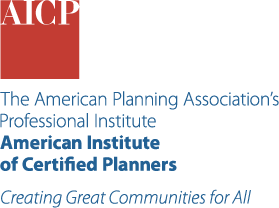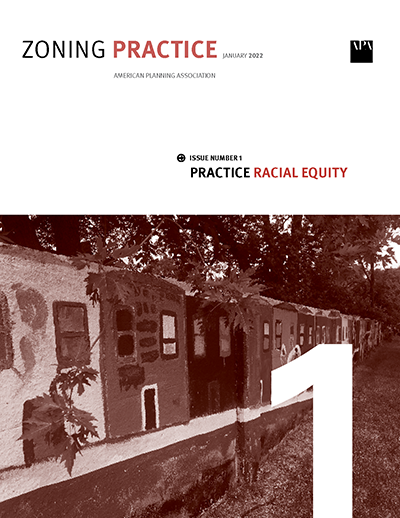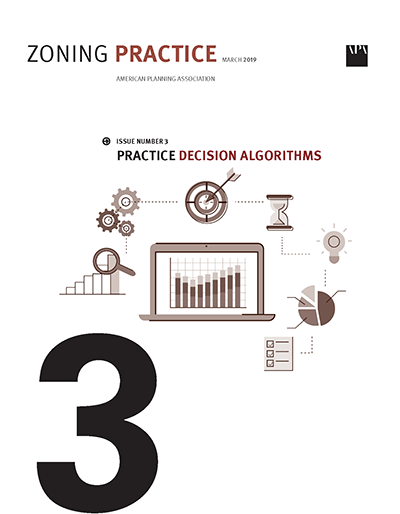Looking for education on this topic?
Check Out Our Passport Courses
Passport is your ticket to the training, experiences, and connections that will take you where you want to go in your planning career. Subscribe for unlimited access for one year to APA's extensive learning library of solution-oriented content facilitated by planners, for planners.
-
Immerse Yourself! Youth and XR Master Planning
Explore Mesa, Arizona's use of VR/MR to create new engagement strategies, starting with youth and civic planning. These immersive technologies bring abstract concepts like TOD and climate-adaptation to life, allowing for experiential understanding and participatory decision-making across diverse groups.- Sarah Bassett
- Nicholas Pilarski
- Bruce Meighen, AICP
#9293807CM | 0.75Data Centers Evolved: A Primer for Planners
From zoning to permitting and everything in between, here's what you need to know to set your community up for success for the next generation of digital infrastructure.by: Jacques Fluet July 22, 2021As our lives and cities become more connected, a combination of traditional and new "edge" data centers will be required. How can planners prepare for this next generation of digital infrastructure?Planning With Artificial Intelligence
PAS Report 604by: Thomas Sanchez June 01, 2023Artificial intelligence can help planners by enhancing current planning procedures, increasing efficiency, and allowing them to refocus their work on the human components of planning.Nonmembers$25.00APA members & PAS subscribers$0.00What Is Planning?
While architects often focus on a single building, a planner's job is to work with residents and elected officials to guide the layout of an entire community or region. Planners take a broad viewpoint and look at how the pieces of a community — buildings, roads, and parks — fit together like pieces of a puzzle.Resilience Strategies along the Rural-Urban Transect
2015This report provides guidance for identifying and prioritizing actions using a “rural-to-urban transect” planning tool.Suwanee, GA, Suwanee's 20/20 Vision
2020This standalone policy is the guiding vision leading city officials and the projects that are considered or implemented.Our Post-Pandemic Future Could Be a Lot Less Car-Centric
Planners are turning open streets pilots and parklet pop-ups into long-term plans for more equitable, sustainable transportation networks.by: David KanerCOVID-19 has highlighted an existing need to rebalance our streets by prioritizing equitable mobility options, not private vehicles. These are the strategies planners are using to make that happen — and for the long term.The New Rules of Urban Reforestation
How ReLeaf Cedar Rapids is rebuilding an urban canopy from scratch after a weather disaster with a focus on data and environmental justice.by: Patrick AlvordHow ReLeaf Cedar Rapids is rebuilding an urban canopy from scratch after a weather disaster with a focus on data and environmental justice.YouTube Influencer Dave Amos Brings Urban Planning to the People
The planner and professor explains how social media can be an informal classroom, how San Luis Obispo uses Instagram effectively, and how his video about Gary, Indiana, went viral.by: Meghan Stromberg June 22, 2023The planner and professor explains how social media can be an informal classroom, how San Luis Obispo uses Instagram effectively, and how his video about Gary, Indiana, went viral.Hazard Mitigation Policy Guide
by: American Planning AssociationAPA's Hazard Mitigation Policy Guide positions planners to champion a new approach to mitigation, adaptation, and recovery centered on equity and established research.Intergenerational Community Planning
PAS Report 603by: Irv Katz, Matthew Kaplan December 01, 2022Intergenerational community planning brings together children and youth and older adults for the mutual benefit of both groups and for the community as a whole.Nonmembers$25.00APA members & PAS subscribers$0.00Mayor Victoria Woodards Is Making Tacoma a Place to Come Home To
How the local leader uses partnerships, missing middle infill, and the Housing Supply Accelerator to put more roofs over more heads.by: Lindsay NiemanHow the local leader uses partnerships, missing middle infill, and the Housing Supply Accelerator to put more roofs over more heads.Ending Zoning’s Racist Legacy
Zoning Practice — January 2022by: Jennifer Raitt January 01, 2022This issue of Zoning Practice summarizes how exclusionary zoning practices reinforce patterns of segregation originally established by illegal racial zoning, racially restrictive covenants, and federal policies in the first half of the 20th century. And it highlights steps Boston and Louisville, Kentucky, have taken to begin to rectify these inequities through zoning reforms.List price$0.00ZP subscriber$0.00Ethics of AI-Enhanced Planning
by: Grant Holub-MoormanUncovering JAPA: Discover how AI-enhanced planning can drive urban development while requiring planners to tackle biases, ensure transparency, safeguard privacy, and engage communities to promote ethical and equitable outcomes.Increased Remote Work Could Mean Big Changes for Cities
The pandemic has accelerated the digitalization of work. How can cities faced with excess commercial office space adapt?by: Brian Barth January 01, 2021The COVID-19 crisis has merely accelerated a transformation of work life that has been decades in the making.Advancing Active Living Through Adaptive Reuse
Planning Approaches to Encourage Physical Activity in Small and Rural Communitiesby: Johamary Swena, AICP, Sagar Shah, PhD, AICPThis blog post provides an overview of adaptive reuse as a planning approach to increase physical activity in small and rural towns. It is part of the Everyday Destinations series.Building Resilience with Scenario Planning: An Interview with Dr. Robert Goodspeed
Sponsored content from University of Michigan: Q&A with Dr. Robert Goodspeed, University of Michigan Associate Professor of Urban and Regional Planning, who is launching a 3-day course on Scenario Planning for Urban Futures.Land-Use Policy Could Help Solve the American West’s Water Crisis
As the twin pressures of water shortages and massive growth run the Colorado River dry, planners explore innovative solutions.by: Patrick Sisson June 15, 2023As the twin pressures of water shortages and massive growth run the Colorado River dry, planners explore innovative solutions.Planning for the Needs of an Aging Population
Questions and answers about what communities should know about shifting demographics.by: Meghan Stromberg February 01, 2021Our population is aging. How can planners prepare?Planning for Climate Mitigation and Adaptation
PAS Report 601by: Matthew Bucchin, AICP, Aaron Tuley, AICP July 01, 2022The climate crisis requires communities to mitigate future climate change through the reduction of greenhouse gas emissions and adapt the built and natural environments to the changes taking place, and planners are uniquely qualified to take a leadership role in building a climate-resilient future.Nonmembers$25.00APA members & PAS subscribers$0.00The New Animal Architecture
April 01, 2015Cities are finding creative ways to rethink human-animal connections, including designing homes and the built environment to provide wildlife habitat and encourage biodiversity.The OpenNeighborhood Project: A Fresh Look at Public Participation
PAS Memo — January/February 2011The OpenNeighborhood approach to public participatory planning, tested in 2009 in Acton, Massachusetts, used digital tools, the virtual-reality game Second Life, and hands-on art exercises to bring into the planning process people who had never participated before.Right-Sizing Transportation Investments
With fewer resources because of COVID-19, cities are turning to an emerging practice that offers practical techniques to recalibrate their existing transportation infrastructure with economic realities and social returns.August 01, 2020Right-sizing transportation tools and approaches can generate new types of projects to support economic recovery and performance, especially in cases of limited resources.The People's Way
Planning with Native American communities calls for looking to the past to guide the future.August 01, 2017Communication and collaboration — particularly with longstanding traditions — are critical for successful planning in Native American communities.Accelerating Change: Bend, Oregon, Explores New Ways to Advance Its Community's Vision
PAS Memo — March/April 2013Bend 2030 is working with key local stakeholders to launch a handful of publicly generated "vision accelerator" projects — bold, collaborative, cross-sectoral initiatives developed with input from the wider public that have the power to significantly alter the community for the betterOpening the Door to Unconventional Homes
Zoning Practice — March 2025This issue of Zoning Practice explores the rise of unconventional housing types, such as barndominiums, 3D-printed homes, and shipping-container homes, and examines common regulatory barriers and potential regulatory reforms planners and local officials may be able to use to foster housing innovation and advance sustainable, resilient, and inclusive housing solutions.8 Steps to an Effective Code Transition
Zoning Practice — January 2023This issue of Zoning Practice summarizes when and why it may be necessary for a city, town, or county to replace an existing development code. It provides an overview of the code-transition process, offering a brief instructional guide on how to organize and complete each step.Making Sustainability Mainstream: The 5A Planning Approach and the Rogers Innovation Adoption Curve
PAS Memo 123To gain broad adoption of sustainable practices, planners need to make such practices easier and more attractive than the status quo. The 5A planning approach and the Rogers innovation adoption curve are two concepts planners can use to move towards a new sustainability paradigm.3 Insights into the Future of Food Production
From gene editing to space tomatoes, here are some innovative approaches from the "2024 Trend Report for Planners."by: Jon DePaolis March 28, 2024From gene editing to space tomatoes, here are some innovative approaches from the "2024 Trend Report for Planners."Reuniting a Divided America
March 01, 2017Humanizing and relaxing the community meeting format allows for all voices to be expressed in a variety of different ways — not just in a public meeting where oftentimes the loudest voices are the only ones heard.Artificial Intelligence and Planning Practice
PAS Memo 111Artificial intelligence represents an emerging planning toolbox that enables a range of new capabilities, but whether it primarily benefits entire communities or narrow interests depends on planners’ abilities to engage with the challenges and opportunities surrounding its civic applications.Advance Environmental Justice Goals with This Innovative Health Data Tool
The City Health Dashboard could help communities meet Justice40 mandates, win funding from the Infrastructure Investment and Jobs Act, and improve health outcomes for all.by: Linda McIntyre, AICP December 12, 2022The City Health Dashboard could help communities meet Justice40 mandates, win funding from the Infrastructure Investment and Jobs Act, and improve health outcomes for all.Placemaking on a Budget
PAS Report 536by: Al Zelinka, FAICP, Susan Harden, FAICPPublic spaces are struggling in many communities. This PAS Report offers help for planners who need to create distinctive public spaces that enhance community identity and social connections — without breaking the bank.List Price$25.00APA member & PAS subscriber$0.00High Growth Utah Communities Push for Federal Housing Support
by: Brenna DoneganAPA Utah President Tippe Morlan, AICP, sits down to talk about how high growth communities in Utah are tackling the housing crisis through zoning reform.Applying Algorithms to Land-Use Decision Making
Zoning Practice — March 2019by: Norman Wright, AICPThis issue of Zoning Practice reviews simple methods for defining and applying a decision algorithm for land-use cases, and it explores how back testing; best-case, worst-case scenarios; and extrapolation can improve this approach.List price$10.00ZP subscriber$0.00The Art of Public Engagement
Planners and communities get creative with the planning process.December 01, 2018Art means different things to different people, which is just one of the reasons why public art is so effective at engaging community members of all backgrounds in the planning process.The Use of Foresight and Scenario Planning in Hazard Mitigation and Climate Adaptation Planning
PAS Memo 113Foresight and exploratory scenario planning is a particularly useful tool in planning for natural hazards and adapting to climate change, given the complexity and uncertainty involved in both of these areas.Q & A
Planning’s editor in chief, Meghan Stromberg, talks to planners and others who are shaking up the status quo.Conversations about three areas of disruption to the transportation status quo: autonomous vehicles/tiny cars, bike sharing, and ride sharing.Norfolk, VA, Missing Middle Pattern Book
Adopted June 2021This guide is designed to help property owners and developers add "missing middle" housing to established low-density neighborhoods in Norfolk, Virginia.Mapping for the Masses
Sustainability planning just got more accessible with a free suite of GIS apps and datasets from Esri.May 01, 2017In June 2016, Esri launched the Green Infrastructure Initiative, a website that offers free access to an enormous cache of GIS data for the U.S.Conservation Limited Development for Local Governments
PAS Memo — March/April 2019Local governments may serve as limited development initiators, sponsors, master developers, project managers, partners, funders, or approving agencies. This PAS Memo focuses mostly on the role of local governments as master developers, as it is the most complex and illustrates points that also apply for simpler approaches.Local Bicycle Master Planning: Connecting Communities
PAS Memo — November/December 2013While recreational bicycling has long enjoyed popularity, bicycling for transportation has not been viewed as a mainstream mobility option until relatively recently. A bicycle master plan is an instrumental blueprint for building bikable communities, and the process of creating one is a means of prioritizing active transportation to meet community environmental, health, and fiscal goals.Terminology of Low Impact Development: Distinguishing LID From Other Techniques That Address Community Growth Issues
March 2012This fact sheet defines several concepts related to low-impact development (LID).Moving Planning Commission Meetings Online During the COVID-19 Pandemic: A Big-City Perspective
In this podcast episode, hear from Emily Mack — director of the Department of Metropolitan Development for the City of Indianapolis, Indiana — about how the city continued with its planning commission and other board meetings during the COVID-19 pandemic.Best-Case Scenario Planning
Incorporating AV and other technology into plans.Change and uncertainty — from technology to climate change to shifts in the economy — are disrupting the planning tradition of mid- and long-range forecasts. Scenario planning can be a powerful tool for incorporating uncertainty.How El Paso Reimagined Capital Improvement Planning During COVID-19
When projected revenue shortfalls put most of the City of El Paso’s scheduled capital improvement projects on hold, planners in this Texas border city saw an opportunity to rethink the capital improvement planning (CIP) and budgeting process. In this podcast episode, listeners learn exactly how they reprioritized projects using an equity-focused approach.Beyond Building
There are plenty of ways to provide for affordable housing that don’t involve new construction.In many cities, solutions often seem equated exclusively with new construction. But affordable housing provision is more than just building houses.Here Come The Robot Cars
Autonomous vehicles will impact the built environment. The time to plan for it is now.In the next few years, autonomous vehicles — driverless cars, self-driving cars, and robot cars — will usher in a transformation of our landscape similar to the one brought on by the Model T more than a century ago.Charlotte, NC, Pilot Park Program
2015This guide provides an overview of the process of creating parklet in Charlotte, North Carolina.Charlotte, NCPlanning Accessible Communities
PAS Memo 117The ADA self-evaluation and transition plan process is a vital first step in addressing the accessibility of both the built environment and municipal programs and services to create truly inclusive communities.















